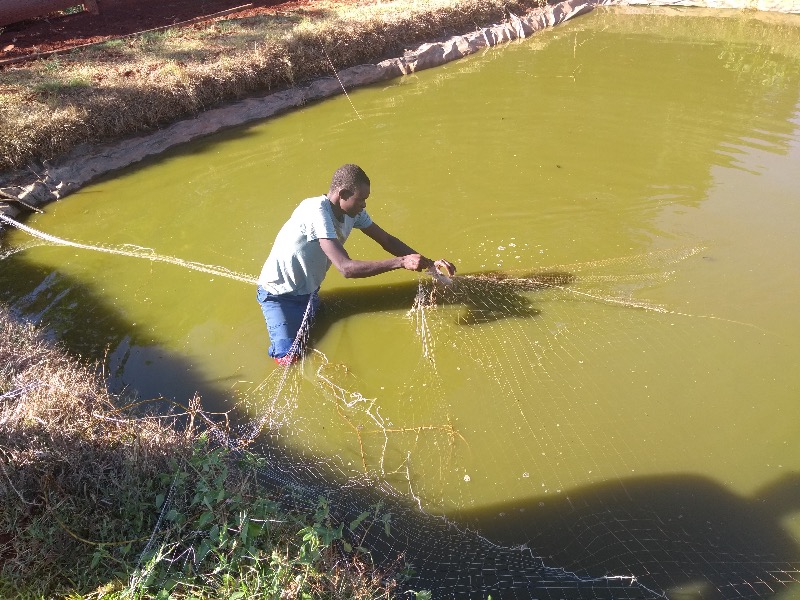- Forum
- categories
- Resource recovery
- Greywater, blackwater or wastewater reuse, irrigation
- Blue green algae in treated wastewater and lakes (city of Bengaluru, India)
Blue green algae in treated wastewater and lakes (city of Bengaluru, India)
19.4k views
Maybe my inputs provide some help to your endeavours.
Maybe see 19 min video presentation 2016 by Dr Ian Dodkins of Swansea University, UK about subject matters most:
Dr Ian Dodkins talks about the function and design of "Floating Treatment Wetlands". Looking at floating islands around the world Ian shows us how floating islands have been used to treat polluted water, protect coastal areas from erosion and used as a place to live.
Summary: clear statements regarding N&P !!! ~ 7% & ~ 6% "uptakes" (uptake by plants) compared to the ~ 62% N & ~ 75% P reduction effects by biofilm including sedimentation and periodic desludging of the sediments after a maximum of ~8 years.
Furthermore see PDF about Dr Ian Dodkins 2014 work: www.floatingislandinternational.com/wp-c...loads/2018/07/29.pdf
Kindly see page 33 for the picture of his theoretical model!
additional PDF by Headley & Prof. Tanner, NZ 2006: www.aucklandcity.govt.nz/council/documen...d%20Review-Final.pdf
picture source Headley & Tanner: www.aqua-verde.de/attachments/Image/Biof...jpg?template=generic
We use under our climatic conditions additional floating OLOIDs (see www.aqua-verde.de/attachments/Image/alle...jpg?template=generic) in pond-wwtp's and lakes to gently equalize water body and add O2. We call it an Open Source "Mangrove"-wwtp.
See picture of ~500 p.e. wwtp: www.aqua-verde.de/attachments/Image/2018...jpg?template=generic
Best Regards,
Detlef SCHWAGER
"simple" Sanitation-Solutions by gravity
Low-Tech Solutions with High-Tech Effects
"Inspired by Circular Economy and Cooperation"
www.flickr.com/photos/aqua-verde/
Please Log in to join the conversation.
You need to login to reply- Heiner
-

- I am a retired organic farmer and interested in nutrient cycles. As an volunteer I now travel mainly to poor countries and together with locals I would like to find new ways of sustainable agriculture. This is beyond the regulations of IFOAM.
Less- Posts: 80
- Karma: 1
- Likes received: 67
see attached a picture of a green fishpond in Zimbabwe. I was told there are hundreds of fish in this pond. Since there was no pump or any other equipment to add oxygen, I think it was a well balanced fishpond. No fish was at the surface, snaping for air.
The ec value was 450 micro-siemens (one crucial point?) and as far as I know, no human wastewater was poured in.
But I know from sweden the combination of fish production and wastewater treatment is possible in in well balanced system. It needs harvesting from time to time....
writes the farmer
Attachments:
-
 fishpondzim.jpg
(Filesize: 397KB)
fishpondzim.jpg
(Filesize: 397KB)
Please Log in to join the conversation.
You need to login to replyPlease Log in to join the conversation.
You need to login to replyI am revisiting this page again after getting a reply from Elisabeth for my comment. I have few questions
1) how many ponds are seen with Blue Green Algal forms.
2) Do you have any data on the Blue green algal forms (names, quantity and problems?
3) How many months in a year you have notice BGA forms or other forms of algae?
4) What is the nitrate and phosphate levels in the pond waters over a period of months?
5) What is the depth of the pond water?
6) Can you associate with a few to conduct experiments / to initiate a remediation work in a small pond?
Please Log in to join the conversation.
You need to login to replyThere are ways to approach this subject. We are in tropics. The algal flora differs from place to place according to water quality and weather conditions. I had seen some ponds occupied by Chlamydomonas, Euglena, Scenedesmus, Melosira, Navicula, Nitzschia, Oscillatoria, Pediastrum, Chlorella, etc. In some areas, Euglena, a single species alone thriving when the water level goes down (organic and chemical enrichment happens). In other areas, Oscillatoria, is dominant and in some Scenedesmus is dominant. No harm in comparing temperate reports with tropical ones. Yes. algal blooms - microcystis producing toxins pose problems in few pockets. Literature survey will add more knowledge to this.
True there will be eutrophication, oxygen depletion and fish kill etc. associated to water ponds.
Ultimately our approach - what we are going to do and what technology we deploy to reduce the pollution, what will be the output - solid mass to liquid etc. matters for us to decide.
We worked on a technology to use only algae (select according to the substrate) to remediate waste waters.
Please Log in to join the conversation.
You need to login to reply- Elisabeth
-
- User is blocked
- Freelance consultant since 2012
Less- Posts: 3372
- Karma: 54
- Likes received: 932
Re: Blue green algae in treated wastewater
You wrote: "I do not see any harm in algal blooms happening when the nutrient levels go up". I disagree with that. Algae blooms are indeed a problem, as was outlined in several posts in this thread before yours, e.g. by Dean and Ian. Ian wrote:
There is also the issue of oxygen depletion and fish kill which Dean already mentioned. See also the Wikipedia article on eutrophication:the main concern may be by-products of the algal blooms, namely toxic microcystins, which may enter the aquifers.
en.wikipedia.org/wiki/Eutrophication
Eutrophication (from Greek eutrophos, "well-nourished"),[1] or hypertrophication, is when a body of water becomes overly enriched with minerals and nutrients which induce excessive growth of algae.[2] This process may result in oxygen depletion of the water body.[3] One example is an "algal bloom" or great increase of phytoplankton in a water body as a response to increased levels of nutrients. Eutrophication is often induced by the discharge of nitrate or phosphate-containing detergents, fertilizers, or sewage into an aquatic system.
Regards,
Elisabeth
Freelance consultant on environmental and climate projects
Please Log in to join the conversation.
You need to login to replyPlease Log in to join the conversation.
You need to login to reply- Vishwanath
-
 Topic AuthorLess
Topic AuthorLess- Posts: 6
- Karma: 1
- Likes received: 4
- Heiner
-

- I am a retired organic farmer and interested in nutrient cycles. As an volunteer I now travel mainly to poor countries and together with locals I would like to find new ways of sustainable agriculture. This is beyond the regulations of IFOAM.
Less- Posts: 80
- Karma: 1
- Likes received: 67
just read an article (GEO, 2011) about algae...
Do you know the company "Aquaflow" in Blenheim? In this article was written they use successful varieties for wastewater treatment. Perhaps they can suppress the blue green algae?
Cheers,
Heiner
Please Log in to join the conversation.
You need to login to reply- Heiner
-

- I am a retired organic farmer and interested in nutrient cycles. As an volunteer I now travel mainly to poor countries and together with locals I would like to find new ways of sustainable agriculture. This is beyond the regulations of IFOAM.
Less- Posts: 80
- Karma: 1
- Likes received: 67
I understand very well your sceptical approach towards water hyacinth. And if there are other payable solutions with less danger to the whole environment....would be great.
Just to prevent misunderstandings: I am not talking about a self regulating biological system. More like this as one example:
In my mind I compare it with a agroforestry system. You have to cut (and use) the outgrowing leaves at the right time, you need a good management to get the benefits. If you don't you might end up with a forest and no food. But to increase the fertility and the humus content of the arable land (fixing Carbon), we need all sorts of organic including the minerals in them.
Cheers
Please Log in to join the conversation.
You need to login to reply- Ian
-
 Less
Less- Posts: 11
- Karma: 5
- Likes received: 8
looking at Bengaluru on Google Earth, it seems that almost all the lakes in and around the city are heavily enriched with algae and/or hyacinth. This indicates that not only is the treated wastewater having an impact on the surface waters, but also the general runoff from the storm-water systems and other drainage which does not go to the treatment works. So there is no short term easy solution to the challenges you face.
However if your aim is to recharge the aquifers and not to use the water directly from the lakes for irrigation, the main concern may be by-products of the algal blooms, namely toxic microcystins, which may enter the aquifers. the algae themselves will not infiltrate into the aquifers. As mentioned by others, the health of the surface water resource is another matter. We normally avoid the use of hyacinth if possible as it can very quickly get out of hand chocking the water body, increasing evapo-transpiration, and rendering the water body un-usable for most recreation activities.
So finally assess the other runoff that may be entering each of the lakes to see if the improvement of the treated sewage through BNR will have a real impact before embarking on this costly upgrade, while also considering the multi-purpose use of each of the lakes. Good wishes, Ian
Please Log in to join the conversation.
You need to login to replyThe solution is to harvest the water hyacinth, which removes nutrients from the lake. The plant matter can be composted or digested and the nutrients and carbon can be used for agriculture. But how expensive is that?
Fish can also be used to "digest" macrophyte plants in the lake but the high nutrient status will always be problematic, the balance is going to be precarious. Remove macrophytes and algae move in.... and too much photosynthetic biomass and oxygen depletion occurs.
cheers
Dean
Vermifilter.com
www.vermifilter.com
Please Log in to join the conversation.
You need to login to reply- Forum
- categories
- Resource recovery
- Greywater, blackwater or wastewater reuse, irrigation
- Blue green algae in treated wastewater and lakes (city of Bengaluru, India)







